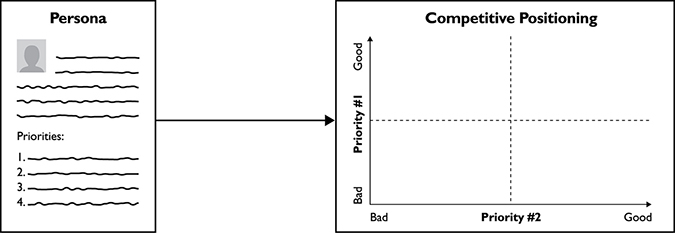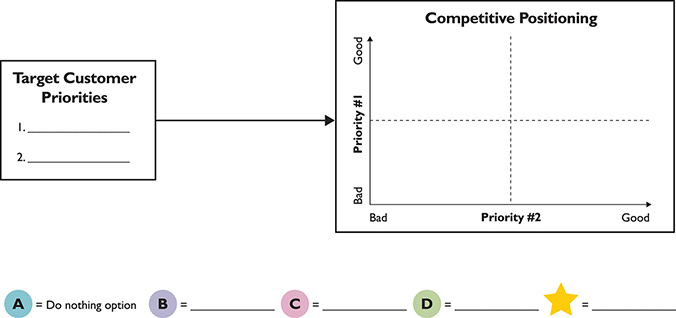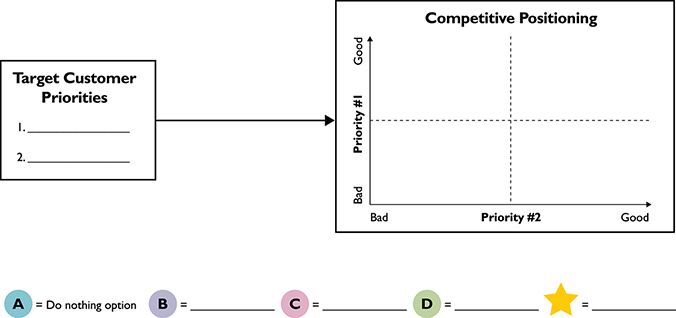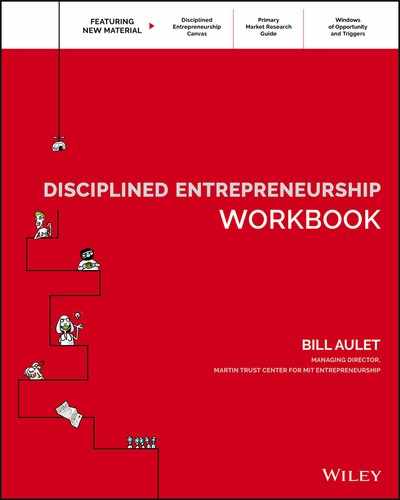STEP 11
Chart Your Competitive Position
WHAT IS STEP 11, CHART YOUR COMPETITIVE POSITION?
Look at your product, versus your Persona’s alternative options, through the lens of the Persona’s top two priorities.
WHY DO WE DO THIS STEP, AND WHY DO WE DO IT NOW?
Customers don’t really care about your Core. What they care about are the unique benefits to them in the areas they are most concerned about. Now that you have identified your Core, you can leverage it and your value proposition to demonstrate whether your product truly represents a breakthrough in the customer’s mind.

The Competitive Position shows your customer how you differentiate from the other options over the long term and shows your team why you will be a long-term success.
PROCESS GUIDE
This step spends some time thinking about your competition, but not too much. Often, entrepreneurs spend far too much time on competitors at the expense of focusing on their target customer—especially when they start doing feature-by-feature comparisons with their competitors. Remember, customers don’t care about features; they care about benefits!
You must know the major competitors, especially that incredibly persistent one known as the “do nothing” option, and at some point later on you’ll want to do a more robust analysis of your competition, asking holistic questions like what is the competitor’s strategy, who funds them, who are their key customers, and what are the strengths and weaknesses of the leadership team.
But you’re not there yet! You’re still too early, and there’s a lot that you need to define for your own company first. The Competitive Position is designed to quickly make sure you have fundamentally differentiated yourself from your competition and that your customer sees you are uniquely positioned to create sustainable, superior value for them. If you have properly defined a strong Core, this exercise turns out to be relatively easy.
You’ll use the Competitive Positioning worksheet in conjunction with your primary market research on your Persona’s top priorities. Take the Persona’s top two priorities and put them on the worksheet’s grid, as shown in the diagram below.

Then plot all the major alternatives the customer has, including the “do nothing” option. Options that are plotted closer to the lower-left corner are bad in all dimensions, whereas options plotted toward the upper-right corner are very attractive.

Finally, plot your position. Strengthened by your Core and your primary market research-backed work throughout the 24 Steps, you should naturally find yourself in the upper-right corner. If you are not in the upper-right corner, then you should be concerned.
If you are not in the upper right hand corner, you need to go back and revisit your Core and your market selection. Don’t enter into a long battle you don’t have a game plan to win.
This exercise is really quite simple, which is the benefit and the weakness of this approach as well. It gives you valuable insights to spot problems and gives you a strong general competitive plan, but there is a lot more detail you’ll need once you enter the market. At that point, you will need a much more detailed competitive tactical plan to stay abreast of the competition and win.

GENERAL EXERCISE TO UNDERSTAND CONCEPT
- Competitive Positioning for Well-Known Companies: Choose two well-known companies and map their Competitive Positioning on the two worksheets provided below. Suggested candidates for this exercise: Uber, Apple, Airbnb, Zappos, IBM, Nordstrom, Starbucks, McDonalds, Volvo.


WORKSHEET
Now apply the same framework to your new venture and tie back to Step 10, Define Your Core, in the final question.

